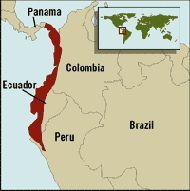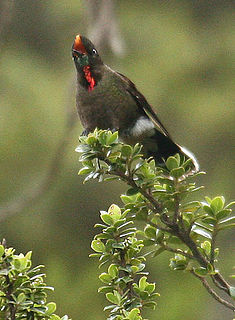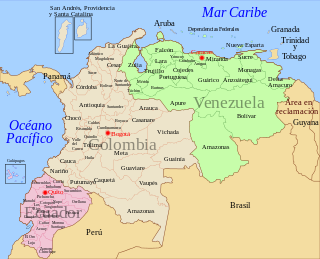Related Research Articles

Ecuador, officially the Republic of Ecuador, is a country in northwestern South America, bordered by Colombia on the north, Peru on the east and south, and the Pacific Ocean on the west. Ecuador also includes the Galápagos Islands in the Pacific, about 1,000 kilometres (621 mi) west of the mainland. The capital is Quito.

An apostolic vicariate is a territorial jurisdiction of the Catholic Church under a titular bishop centered in missionary regions and countries where dioceses or parishes have not yet been established. It is essentially provisional, though it may last for a century or more. The hope is that the region will generate sufficient numbers of Catholics for the Church to create a diocese. In turn, the status of apostolic vicariate is often a promotion for a former apostolic prefecture, while either may have started out as a mission sui iuris.

Oncidium, abbreviated as Onc. in the horticultural trade, is a genus that contains about 330 species of orchids from the subtribe Oncidiinae of the orchid family (Orchidaceae). As presently conceived, it is distributed across much of South America, Central America, Mexico and the West Indies, with one species (O. ensatum) extending into Florida. Common names for plants in this genus include dancing-lady orchid and golden shower orchid.

The Ecuador national football team has represented Ecuador in men's international football since 1938 and is controlled by the Ecuadorian Football Federation. They joined FIFA in 1926 and CONMEBOL a year later.

Tumbes-Chocó-Magdalena is a biodiversity hotspot, which includes the tropical moist forests and tropical dry forests of the Pacific coast of South America and the Galapagos Islands. The region extends from easternmost Panama to the lower Magdalena Valley of Colombia, and along the Pacific coast of Colombia and Ecuador to the northwestern corner of Peru. Formerly called the Chocó-Darién-Western Ecuador Hotspot, it has been expanded to include several new areas, notably the Magdalena Valley in northern Colombia. It is bounded on the east by the Andes Mountains. The Tumbes-Choco-Magdalena Hotspot is 1,500 km long and encircles 274,597 km². Tumbes-Choco-Magdalena is near the Pacific Ocean. The factors that threaten Tumbes-Choco-Magdalena are farming encroachment, deforestation, illegal crops, and population growth. Whereas the Panamanian and Colombian portion of the hotspot are relatively intact, approximately 98% of native forest in coastal Ecuador has been cleared, rendering it the most threatened tropical forest in the world. The hotspot includes a wide variety of habitats, ranging from mangroves, beaches, rocky shorelines, and coastal wilderness to some of the world's wettest rain forests in the Colombian Chocó. The hotspot includes a number of ecoregions:

Luis Fernando Suárez Guzmán is a Colombian retired football player, who played as a defender, and most recently the manager of Colombian side Junior. He has managed in five Latin American countries: Colombia, Ecuador, Peru, Honduras and Mexico.

Huntleya is a small orchid genus native to South America, Central America and Trinidad.

Pitcairnia is a genus of plants in the family Bromeliaceae, subfamily Pitcairnioideae. It was named for Dr. William Pitcairn, Scottish physician and gardener (1711–1791). The genus Pitcairnia ranks as the second most prolific of the bromeliad family. They are most abundant in Colombia, Peru and Brazil, but can also be found in areas from Cuba and Mexico south to Argentina. One species, Pitcairnia feliciana is found in tropical West Africa and is the only member of the family Bromeliaceae not native to the Americas.

Gran Colombia is the historiographical designation for the state, then known simply as Colombia, that encompassed much of northern South America and part of southern Central America from 1819 to 1831. The state included the territories of present-day Colombia, Ecuador, Panama and Venezuela, and parts of northern Peru and northwestern Brazil. The term Gran Colombia is used historiographically to distinguish it from the current Republic of Colombia, which is also the official name of the former state.

The rainbow-bearded thornbill is a species of hummingbird in the family Trochilidae. It is found in Colombia, Ecuador, and Peru. Its natural habitat is subtropical or tropical high-altitude grassland.

The white-banded swallow is a species of bird in the family Hirundinidae. They are black with white thighs, a white breast, and white bars on the edges of its wings. They have a distinct, deeply forked tail.
The Colombia national under-17 football team represents Colombia in international under-17 football competitions and is overseen by the Colombian Football Federation.

The 2008 Andean diplomatic crisis was a diplomatic stand-off between the South American countries of Ecuador, Colombia and Venezuela. It began with an incursion into Ecuadorian territory across the Putumayo River by the Colombian military on March 1, 2008, leading to the deaths of over twenty militants, including Raúl Reyes and sixteen other members of the Revolutionary Armed Forces of Colombia (FARC). This incursion led to increased tension between Colombia and Ecuador and the movement of Venezuelan and Ecuadorian troops to their borders with Colombia.

The following outline is provided as an overview of and topical guide to South America.

Huntleya fasciata is a species of orchid that occurs from Colombia and northwestern Ecuador to Honduras and Belize.
Auratonota is a genus of moths belonging to the family Tortricidae.

Lycorea halia, the tropical milkweed butterfly, is a species of nymphalid butterfly in the Danainae subfamily. It is found from Peru to the Caribbean and Mexico. Strays can be found as far north as Texas. The habitat consists of rainforest.
Pikelinia is a genus of South American crevice weavers that was first described by Cândido Firmino de Mello-Leitão in 1946.

The Esmeraldas-Pacific Colombia mangroves (NT1409) is an ecoregion of mangrove forests along the Pacific coast of Colombia and Ecuador. It is threatened by human population growth, leading to over-exploitation for wood and clearance for farming and aquaculture.
References
- ↑ "Higginsius Hemming, 1964" at Markku Savela's Lepidoptera and Some Other Life Forms